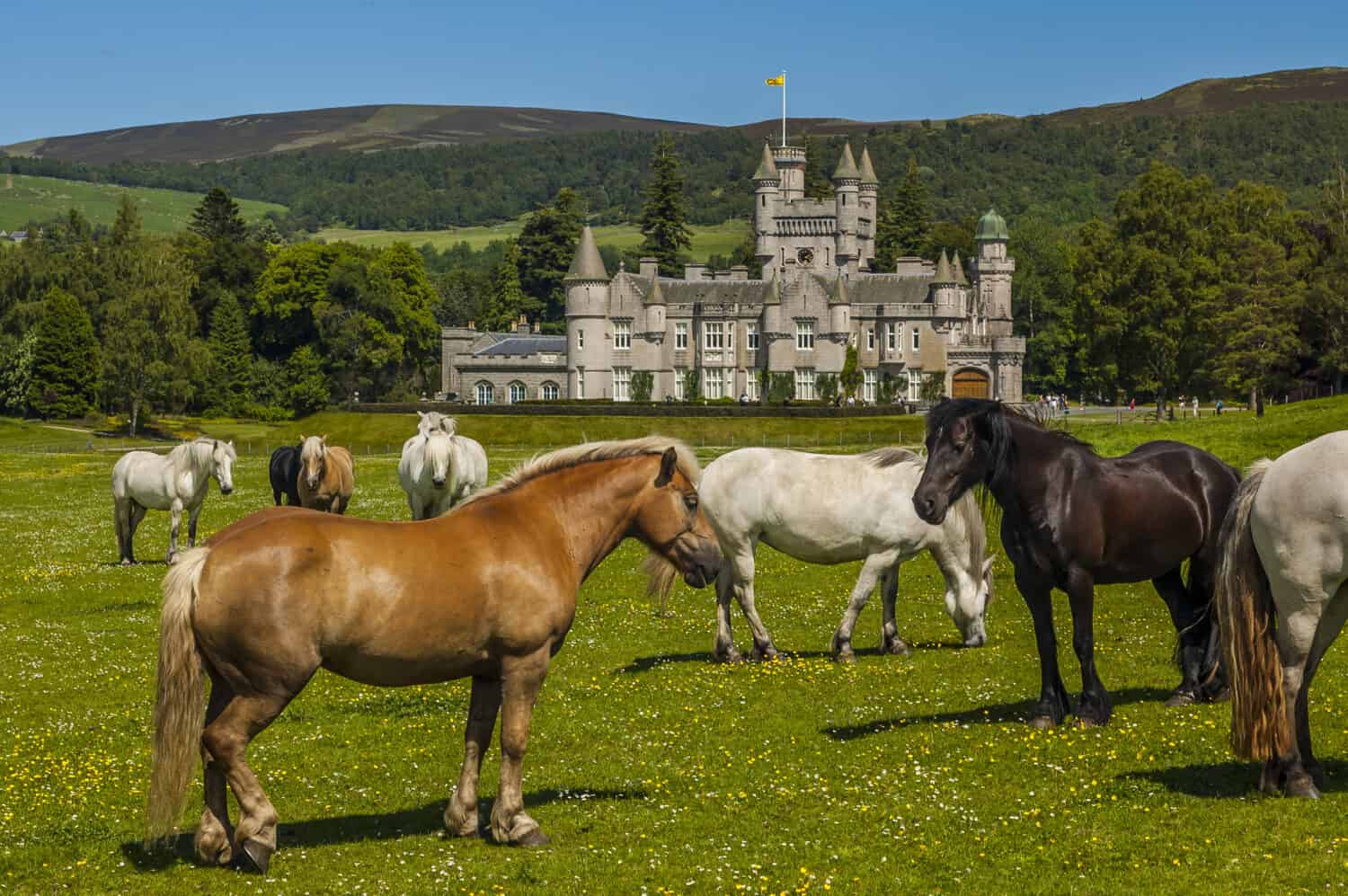Horses, those majestic creatures that have galloped through the annals of history alongside humans for centuries, come in two distinct flavors: males, known as stallions, and females, affectionately referred to as mares. These equine powerhouses differ in more ways than just their gender. From size and physical traits to reproductive roles, temperament, and even suitability for various equestrian activities, stallions and mares have unique characteristics that make them stand out. In this informal but informative exploration, we’ll take you on a ride through the world of male and female horses, unveiling their fascinating distinctions.
| Gender | Size | Physical Traits | Reproductive Roles | Temperment | Equestrian Activities |
|---|---|---|---|---|---|
| Male (Stallion) | 56-68 inches high 900-2,200 pounds | Thicker neck, muscular | Mate and Fertilize | Spirited, competitive, assertive | well-suited for competitive disciplines |
| Female (Mare) | 52-64 inches high, 900-1,600 pounds | Sleeker and more refined | Carry, birth, and nurse | Even-tempered, dependable | well-suited for family horses, pleasure riding |
1. Male vs. Female Horses: Size
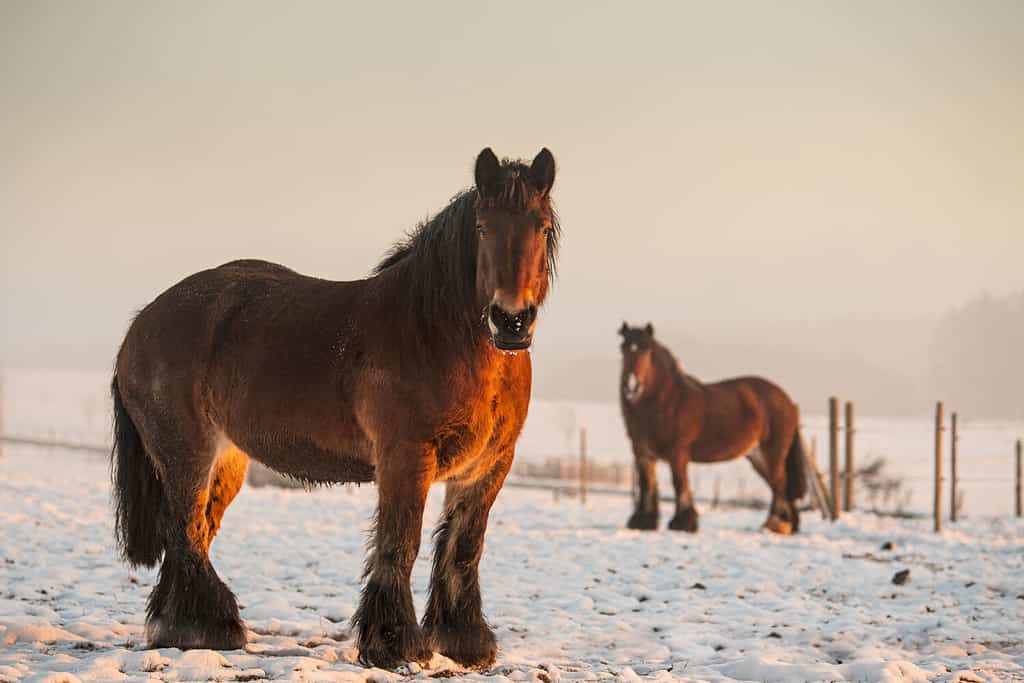
Horses range in size across breeds but also across genders.
©Wirestock Creators/Shutterstock.com
The difference in size between male and female horses, commonly known as stallions (males) and mares (females), is one of the most noticeable distinctions among these majestic animals. Here’s a more detailed explanation of how their size differs:
Stallions (Males):
- Stallions are the larger of the two genders in the equine world. They typically stand at 14 to 17 hands at the withers, equivalent to approximately 56 to 68 inches.
- In addition to their height, stallions often have a more substantial build with a thicker neck, prominent musculature, and a more angular or chiseled appearance.
- Higher testosterone levels primarily influence their larger size and robust physique. This size and strength can make them well-suited for various equestrian activities that require power and agility, such as dressage and show jumping.
Mares (Females):
- Mares, in contrast, are generally smaller than stallions. They stand around 13 to 16 hands at the withers or about 52 to 64 inches in height.
- Mares typically have a sleeker and more refined build. Their physical features are characterized by smoother lines and an elegant appearance influenced by estrogen levels.
- While they may be less imposing in size, mares are highly adaptable and well-suited for a wide range of equestrian activities, including trail riding, pleasure riding, and family horse roles.
2. Male vs. Female Horses: Physical Traits
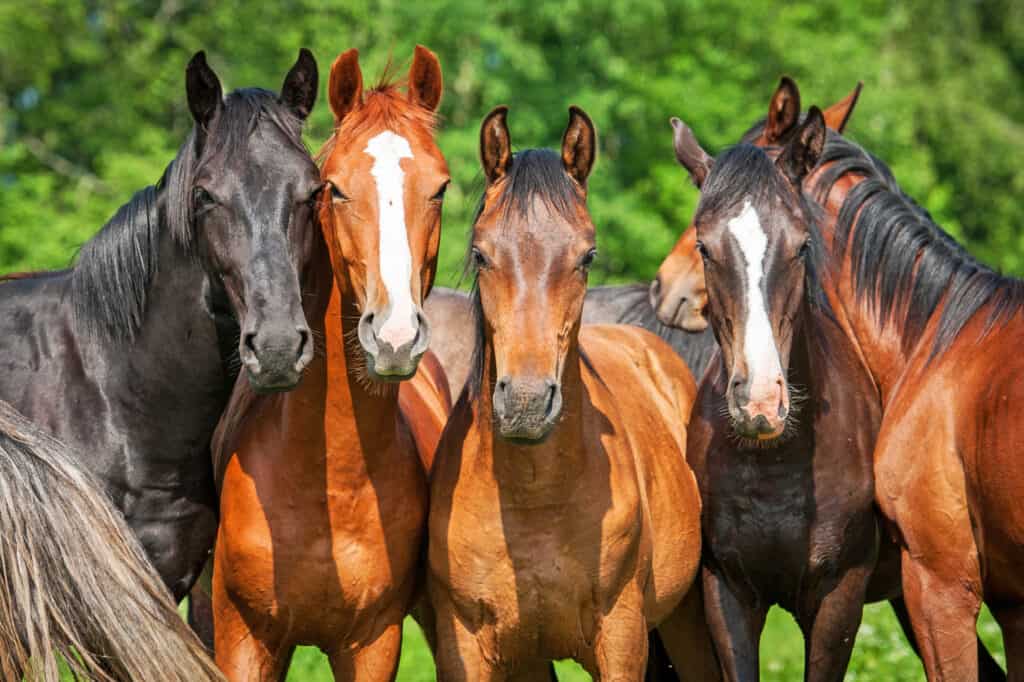
Stallions tend to have more muscular builds than mares.
©Rita_Kochmarjova/Shutterstock.com
Besides differences in size, male and female horses, known as stallions (males) and mares (females), exhibit various distinctions in physical traits. Here’s a more detailed look at these non-size-related differences:
Stallions (Males):
- Neck: Stallions often have thicker and more muscular necks compared to mares. This muscular neck contributes to their imposing appearance and is especially prominent during breeding displays and interactions with other horses.
- Musculature: Male horses tend to develop more prominent musculature throughout their bodies due to their higher testosterone levels. Their broader, more robust build gives them a powerful and sturdy appearance.
- Head and Facial Features: Stallions frequently have broader heads with more angular or chiseled features. Their facial expressions can appear more intense, especially when displaying dominance or interacting with other horses.
Mares (Females):
- Sleek Build: Mares are typically slender and more refined than stallions. Their bodies exhibit smoother lines and a more elegant appearance. This streamlined physique can make them look graceful and agile.
- Facial Features: Female horses often have softer and more delicate facial features. Their heads may appear more refined and less angular than those of stallions. Mares have an air of gentleness in their facial expressions.
These differences in physical traits between stallions and mares are primarily attributed to variations in hormone levels. While these traits are general trends, it’s essential to remember that individual horses can exhibit various physical variations based on breed, genetics, and overall health. These differences are more subtle than size but can provide insights into the gender of a horse when observing their conformation and appearance.
3. Male vs. Female Horses: Reproductive Roles
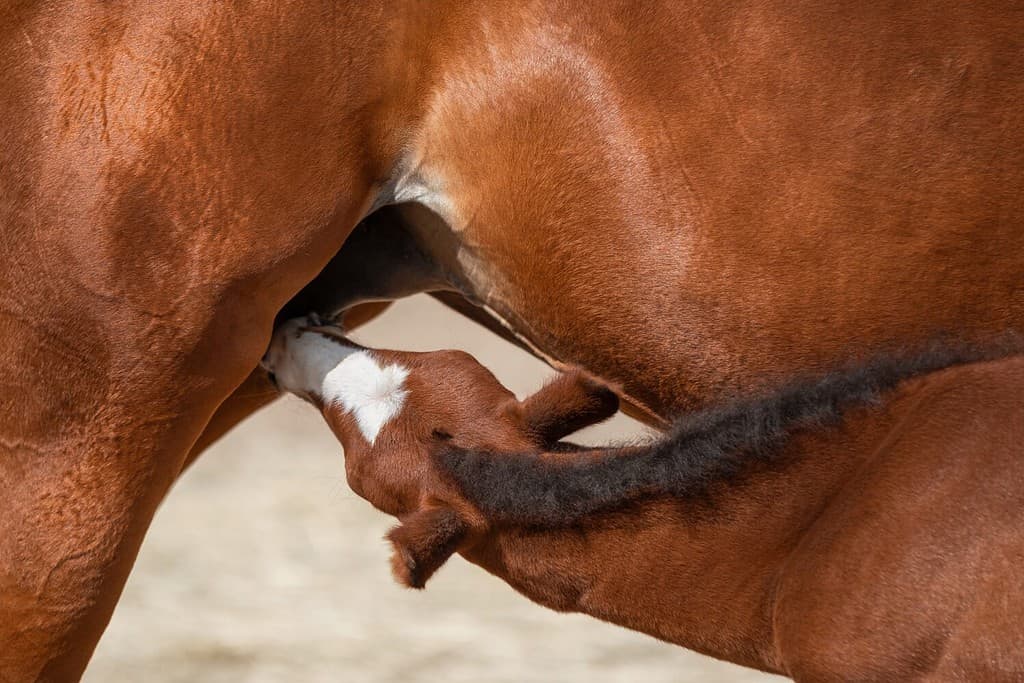
Reproduction is an area in which stallions and mares differ the most.
©marinat197/Shutterstock.com
Male and female horses, known as stallions (males) and mares (females), have distinct reproductive roles in the equine world. These roles are crucial to the continuation of the horse species. Here’s a detailed explanation of the differences in their reproductive roles:
Stallions (Males):
- Fertilization: The primary reproductive role of stallions is to mate with mares for fertilization. Stallions produce and deliver sperm necessary to fertilize the mare’s eggs.
- Courtship: During the breeding season, stallions engage in courtship behavior to attract and impress receptive mares. This behavior may involve vocalizations, displaying physical prowess, and competing with other stallions for the attention of mares.
- Multiple Mares: A single stallion can mate with various mares during the breeding season, a key element in the stallion’s role as a sire.
Mares (Females):
- Carrying and Birthing: Mares have a distinct role in the reproductive process. They are responsible for carrying the developing foal (fetus) within their uterus and giving birth to it. The gestation period for a mare is approximately 11 months.
- Nursing: After giving birth, mares nurse and care for their foals, providing them with essential milk and maternal care. This nurturing role is vital for the survival and well-being of the foal.
- Heat Cycles: Mares go through reproductive cycles known as estrus or “being in heat.” During these cycles, which typically last about 21 days, mares are receptive to mating with a stallion. They exhibit behavioral and physiological signs that signal their readiness to reproduce.
It’s important to note that the reproductive roles of stallions and mares are complementary and essential for the continuation of the horse species. Breeding involves the cooperation of both genders, with stallions providing the genetic material and mares carrying, birthing, and nursing the foals. These roles are intricately connected to horses’ natural behaviors and instincts and are vital in maintaining horse populations.
4. Male vs. Female Horses: Temperament
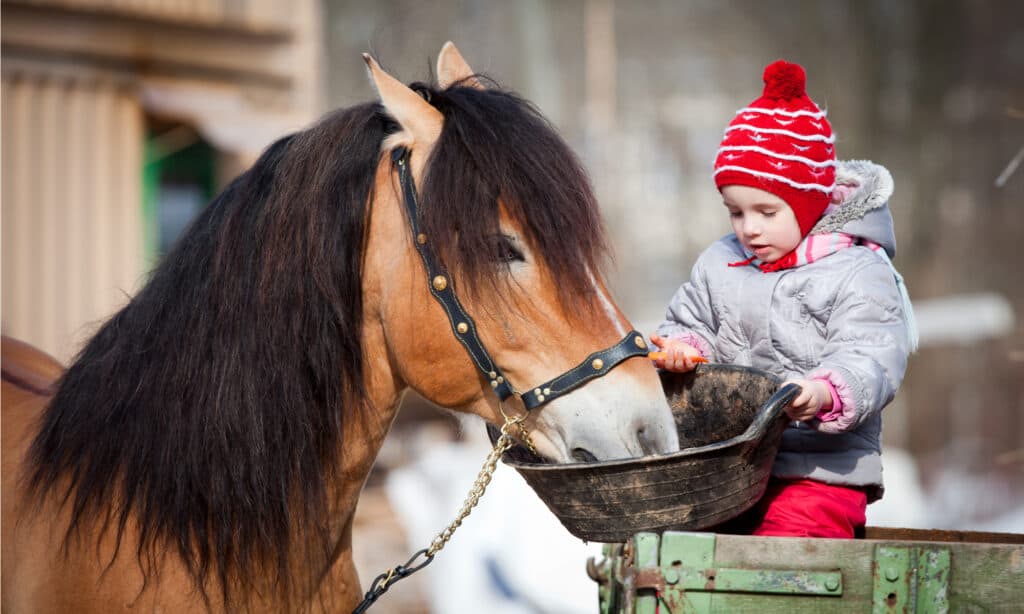
Mares tend to respond better to human interactions, but all horses are unique and have their own personalities.
©Alexia Khruscheva/Shutterstock.com
Differences in temperament between male and female horses, known as stallions (males) and mares (females), are influenced by various factors, including hormonal differences, individual personality, and upbringing. While generalizations can be made, it’s crucial to remember that each horse is unique. Here’s a detailed look at the differences in temperament:
Stallions (Males):
- Boldness and Aggression: Stallions are often associated with higher levels of boldness and aggression, primarily driven by their naturally elevated testosterone levels. This boldness can manifest in assertive behaviors and a desire to establish dominance within a group of horses.
- Competitiveness: Male horses may exhibit a competitive spirit with other stallions and when interacting with mares. This competitiveness can make them more inclined to challenge other horses for leadership or breeding rights.
- Independence: Stallions often display a degree of independence and may have a stronger inclination to explore and roam independently. This independence can make managing them more challenging without the proper training and handling.
- Training and Handling: Proper training and handling are essential for managing stallions. Experienced handlers can work with their natural boldness to establish respect and cooperation, but it may require more patience and skill.
Mares (Females):
- Even-Tempered: Mares are generally considered more even-tempered and dependable than stallions. They tend to have a more predictable disposition, making them suitable for various equestrian activities.
- Nurturing: Mares often exhibit nurturing behavior, especially when caring for their foals. They tend to be gentle and protective mothers, creating strong bonds with their offspring.
- Cooperative Nature: Female horses are more inclined to cooperate with humans and other horses. They may engage in collaborative tasks more readily and are less likely to engage in aggressive behaviors.
- Mood Swings During Estrus: One important consideration is that mares can experience mood swings during their estrus cycles (heat cycles). These fluctuations in hormone levels can lead to changes in behavior, with some mares becoming more sensitive or irritable during this time.
It’s essential to recognize that these are general trends, and individual variations are common. A horse’s temperament can be influenced by genetics, upbringing, training, and the environment in which they are kept. Regardless of gender, a horse’s temperament can be managed and improved through proper training, socialization, and experienced handling. Understanding each horse’s unique characteristics and tendencies, whether a stallion or a mare, is crucial for prosperous and harmonious interactions.
5. Male vs. Female Horses: Equestrian Activities
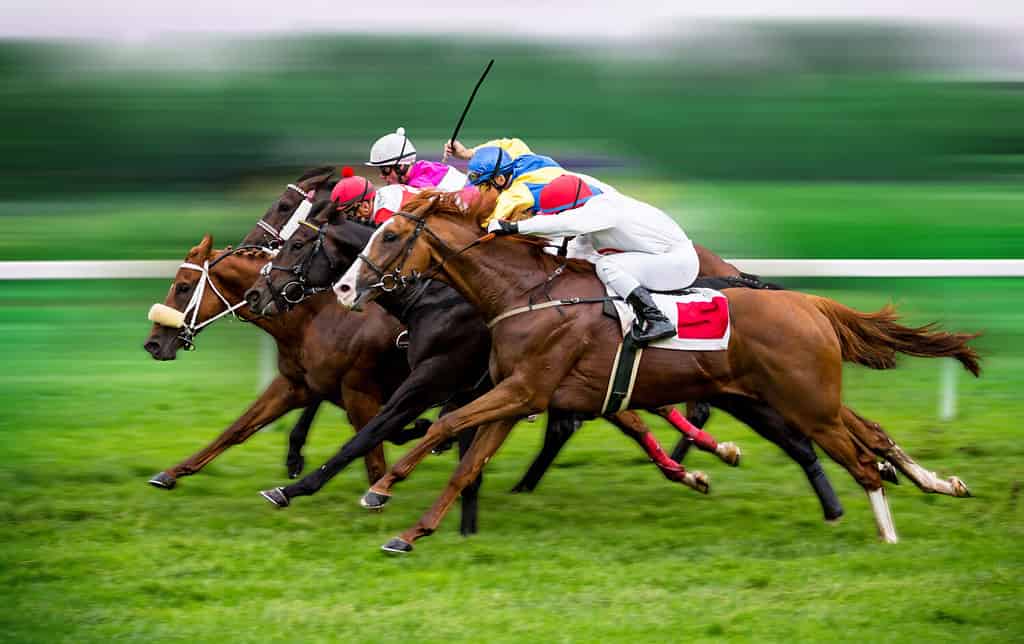
Stallions tend to be better suited for competitive equestrian sports.
©Lukas Gojda/Shutterstock.com
Male and female horses, known as stallions (males) and mares (females), can excel in various equestrian activities. Still, their suitability for specific disciplines can be influenced by temperament, physical attributes, and individual training. Here’s a detailed explanation of how their participation in equestrian activities may differ:
Stallions (Males):
- Strength and Agility: Stallions often possess greater physical strength and agility due to their larger size and robust musculature. This makes them well-suited for equestrian disciplines that demand power, agility, and competitive spirit.
- Competitive Disciplines: Stallions can excel in competitive equestrian disciplines like dressage, show jumping, and driving events. Their natural drive and energy make them suitable for these demanding activities.
- Performance Roles: Stallions are frequently chosen for performance roles in shows and exhibitions. Their presence and imposing appearance can captivate audiences, enhancing the overall performance.
Mares (Females):
- Adaptability: Mares are known for their adaptability and versatility. They are well-suited for various equestrian activities, including trail riding, pleasure riding, and family horse roles.
- Trail Riding: Mares can make excellent trail riding partners due to their even-tempered and dependable nature. Their reliability and trail adaptability make them popular for riders seeking enjoyable, relaxed outings.
- Family Horses: Mares often serve as family horses, providing safe and enjoyable riding experiences for riders of all ages and skill levels. Their nurturing and cooperative nature can make them ideal for family environments.
- Breeding: Mares play a vital role in breeding programs as they carry and give birth to foals. Their ability to nurse and care for their offspring is essential for successful breeding.
It’s important to emphasize that a horse’s suitability for a specific equestrian activity goes beyond gender. Temperament, training, individual talent, and the rider’s skill level are equally important. While there are general trends in the preferences for specific activities based on gender, many stallions and mares are highly successful in a wide range of equestrian pursuits. Ultimately, the horse’s disposition, skills, and compatibility with the rider’s goals are vital considerations when selecting a horse for a particular discipline.
In the world of horses, it’s not just about “boys” and “girls.” Stallions and mares bring their unique flair to the equine stage. The differences extend beyond the obvious physical contrasts. They have their own stories to tell, roles to play, and temperaments to share. Whether you’re a seasoned equestrian or just someone who enjoys watching these magnificent creatures from afar, understanding these distinctions adds a touch of magic to the horse-human connection. So, next time you meet a horse, take a moment to appreciate the individuality and character that comes with their gender, no matter whether they’re a “he” or a “she.”
Thank you for reading! Have some feedback for us? Contact the AZ Animals editorial team.

